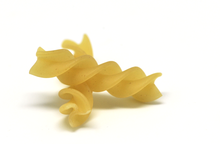Fusilli
 | |
| Alternative names | "Solid" fusilli may also be known as rotini in the United States |
|---|---|
| Type | Pasta |
| Place of origin | Italy |
Fusilli [fuˈzilli] (commonly known as rotini in the United States) are a variety of pasta that are formed into corkscrew or helical shapes. The word fusilli presumably comes from fuso ("spindle"), as traditionally it is "spun" by pressing and rolling a small rod over the thin strips of pasta to wind them around it in a corkscrew shape.[1]
In addition to plain and whole wheat varieties, as with any pasta, other colours can be made by mixing other ingredients into the dough, which also affects the flavour, for example, beetroot or tomato for red, spinach for green,[2] and cuttlefish ink for black.
The term fusilli is also used to describe a short, extruded, twisted pasta known as rotini in the United States.[3]
Variants[]

Fusilli may be solid or hollow. A variant type of fusilli are formed as hollow tubes of pasta that are twisted into springs or corkscrews and are called fusilli bucati. Another variant are twisted long lengths as though spaghetti were coiled around an object known as fusilli lunghi.[3] Fusilli Napoletani are flat lengths of coiled pasta formed around a spindle.[4]
See also[]
References[]
- ^ "The meaning of pasta names - OxfordWords blog". OxfordWords blog. 24 October 2014. Retrieved 25 November 2017.
- ^ "Fusilli recipes". BBC. Retrieved September 25, 2016.
- ^ a b Alfaro, Danilo (3 June 2017). "What's the Difference Between Fusilli and Rotini Pasta?". The Spruce. Retrieved 25 November 2017.
- ^ "Fusilli napoletani". ButtaLaPasta (in Italian). Retrieved 25 November 2017.
External links[]
| Wikimedia Commons has media related to Fusilli. |
- Types of pasta